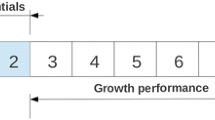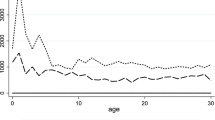Abstract
This paper investigates the relationship between initial research and development (R&D) intensity and firm growth using a unique data set for firms with R&D activities in Austria during the period 1995–2006. Results based on the least absolute deviation (LAD) estimator show that initial R&D intensity has a positive and significant impact on both employment and sales growth in the subsequent 2 years. Quantile regressions for each cross-section reveal that the impact of R&D intensity is significant from 0.3 to the highest quantile of the conditional distribution of employment growth. Furthermore, the elasticity of employment growth with respect to R&D intensity is highest for firms at or slightly below the median of the distribution of firm growth. Finally, we find that the impact of R&D decreases significantly over time.


Similar content being viewed by others
Notes
R&D intensity in the business sector [measured as the ratio of R&D expenditures in the business sector to gross domestic product (GDP)] doubled since the beginning of the 1990s (from 0.9% in 1993 to 1.7% in 2009).
Ideally sales should be deflated by an industry price index. However, the use of growth rates of sales in nominal prices is probably unlikely to produce a bias, since producer price inflation is quite small during the period and does not vary much across industries during the period. Unreported results show that the R&D coefficients do not change when sales in current prices are replaced by sales deflated by an overall price index.
It is well known that growth of R&D capital stock is a better measure than R&D intensity (Mairesse and Hall 1996). However, the available time series are too short for calculating the R&D capital stock. Therefore, the firm growth equation contains R&D intensity as a proxy for the stock of R&D capital.
We use a 2-year lag of R&D intensity since employment and sales growth rate are calculated over a 2-year period and to avoid a simultaneous bias. Foray et al. (2007) also use the R&D-to-sales ratio lagged by 2 years.
Note that the panel quantile regression technique accounting for unobserved individual effects is only available when T is large. For a short time span, quantile regression techniques for panel data are not available.
Regional dummy variables are never significant and are therefore not included in the final specification.
The funding agency plans to collect industry affiliation data from Statistics Austria, which will allow us to categorize the sample firms into different industries.
OLS estimates are reported in Table 9 in the Appendix for comparison purposes.
Estimation is performed using the SQREG command in STATA 10.0.
References
Aghion, P., & Howitt, P. (1998). Endogenous growth theory. Cambridge, MA: MIT Press.
Brouwer, E., Kleinknecht, A., & Reijnen, J. O. N. (1993). Employment growth and innovation at the firm level: An empirical study. Journal of Evolutionary Economics, 3, 153–159.
Coad, A. (2009). The growth of firms: A survey of theories and empirical evidence. Cheltenham: Edward Elgar (forthcoming).
Coad, A., & Rao, R. (2006). Innovation and market value: A quantile regression analysis. Economics Bulletin, 15(13), 1–10.
Coad, A., & Rao, R. (2008). Innovation and firm growth in high-tech sectors: A quantile regression approach. Research Policy, 37(4), 633–648.
Del Monte, A., & Papagni, E. (2003). R&D and the growth of firms: Empirical analysis of a panel of Italian firms. Research Policy, 32, 1003–1014.
Evans, D. S. (1987a). The relationship between firm growth, size and age: Estimates for 100 manufacturing industries. Journal of Industrial Economics, 35(4), 567–581.
Evans, D. S. (1987b). Tests of alternative theories of firm growth. The Journal of Political Economy, 95(4), 657–674.
Foray, D., Hall, B. H., & Mairesse, J. (2007). Pitfalls in estimating the returns to corporate R&D using accounting data. CEMI Working Papers 3. École Polytechnique Fédérale de Lausanne.
Goedhuys, M., & Sleuwaegen, L. (2009). High-growth entrepreneurial firms in Africa: A quantile regression approach. Small Business Economics (forthcoming).
Gould, W. W. (1997). Interquantile and simultaneous quantile regression. Stata Technical Bulletin, 38, 14–22.
Hall, B. H. (1987). The relationship between firm size and firm growth in US manufacturing. Journal of Industrial Economics, 35(4), 583–606.
Hall, B. H. (1993). Industrial research during the 1980 s: Did the rate of return fall? Brookings Papers on Economic Activity, 2, 289–343.
Hall, B. H., Lotti, F., & Mairesse, J. (2008). Employment, innovation and productivity: Evidence from Italian microdata. Industrial and Corporate Change, 17(4), 813–839.
Hall, B. H., Mairesse J., & Mohnen P. (2009). Measuring the returns to R&D. NBER Working Paper 15622. Cambridge, MA.
Harrison, R., Jaumandreu, J., Mairesse, J., & Peters, B. (2008). Does innovation stimulate employment? A firm-level analysis using comparable micro data on four European countries. NBER working paper 14216.
Henderson, R., & Cockburn, I. (1996). Scale - scope - and spillovers: The determinants of research productivity in drug discovery. RAND Journal of Economics, 27, 32–59.
Hölzl, W. (2009). Is the R&D behaviour of fast growing SMEs different? Evidence from CIS III data for 16 countries. Small Business Economics, 33(1), 59–75.
Jovanovic, B. (1982). Selection and the evolution of industry. Econometrica, 50(3), 649–670.
Kaiser, U. (2009). Patents and profit rates. Economics Letters, 104(2), 79–80.
Klette, T., & Forre, S. E. (1998). Innovation and job creation in a small open economy: Evidence from Norwegian manufacturing plants 1982–92. Economics of Innovation and New Technology, 5, 247–272.
Klette, J., & Kortum, S. (2004). Innovating firms and aggregate innovation. Journal of Political Economy, 112, 986–1018.
Koenker, R. (2005). Quantile regression. Cambridge: Cambridge University Press.
Koenker, R., & Bassett, G. (1978). Regression quantiles. Econometrica, 46(1), 33–50.
Koenker, R., & Hallock, K. (2001). Quantile regression. Journal of Economic Perspectives, 15(4), 143–156.
Kortum, S. (1993). Equilibrium R&D and the patent—R&D ratio: U.S. evidence. American Economic Review Papers and Proceedings, 83, 450–457.
Lachenmaier, S., & Rottmann, H. (2007). Employment effects of innovation at the firm level. Jahrbücher für Nationalökonomie und Statistik, 227, 254–272.
Lotti, F., Santarelli, E., & Vivarelli, M. (2009). Defending Gibrat’s Law as a long-run regularity. Small Business Economics, 32, 31–44.
Madsen, J. B. (2007). Are there diminishing returns to R&D? Economics Letters, 95, 161–166.
Mairesse, J., & Hall, B. H. (1996). Estimating the productivity of research and development: An exploration of GMM methods using data on French & United States manufacturing firms. NBER Working Papers 5501. Cambridge, MA.
Ortega-Argilés, R., Piva, M., Potters, L., & Vivarelli, M. (2010). Is corporate R&D investment in high-tech sectors more effective? Contemporary Economic Policy (forthcoming).
Pakes, A. (1985). On patents, R&D, and the stock market rate of return. Journal of Political Economy, 93(2), 390–409.
Parisi, M. L., Schiantarelli, F., & Sembenelli, A. (2006). Productivity, innovation and R&D: Micro evidence for Italy. European Economic Review, 50, 2037–2061.
Petit, P. (1995). Employment and technological change. In P. Stoneman (Ed.), Handbook of the economics of innovation and technological change (pp. 366–408). Amsterdam: North-Holland.
Pianta, M. (2005). Innovation and employment. In J. Fagerberg, D. Mowery, & R. Nelson (Eds.), Oxford handbook of innovation (pp. 568–598). Oxford: Oxford University Press.
Piva, M., & Vivarelli, M. (2004). Technological change and employment: Some micro evidence from Italy. Applied Economics Letters, 11, 373–376.
Piva, M., & Vivarelli, M. (2005). Innovation and employment: Evidence from Italian microdata. Journal of Economics, 86(1), 65–83.
Ravenscraft, D. J., & Scherer, F. M. (1982). The lag structure of returns to research and development. Applied Economics, 14, 603–620.
Spiezia, V., & Vivarelli, M. (2000). The analysis of technological change and employment. In M. Vivarelli & M. Pianta (Eds.), The employment impact of innovation: Evidence and policy (pp. 12–25). London: Routledge.
Stam, E., & Wennberg, K. (2009). The roles of R&D in new firm growth. Small Business Economics, 33, 77–89.
Van Reenen, J. (1997). Employment and technological innovation: Evidence from U.K. manufacturing firms. Journal of Labor Economics, 15(2), 255–284.
Wakelin, K. (2001). Productivity growth and R&D expenditure in UK manufacturing firms. Research Policy, 30, 1079–1090.
Yang, C. H., & Huang, C. H. (2005). R&D, size and firm growth in Taiwan’s electronics industry. Small Business Economics, 25(5), 477–487.
Yasuda, T. (2005). Firm growth, size, age and behavior in Japanese manufacturing. Small Business Economics, 24(1), 1–15.
Zimmermann, V. (2009). The impact of innovation on employment in small and medium enterprises with different growth rates. Jahrbücher für Nationalökonomie und Statistik, 229(2/3), 313–326.
Author information
Authors and Affiliations
Corresponding author
Appendix
Appendix
Rights and permissions
About this article
Cite this article
Falk, M. Quantile estimates of the impact of R&D intensity on firm performance. Small Bus Econ 39, 19–37 (2012). https://doi.org/10.1007/s11187-010-9290-7
Accepted:
Published:
Issue Date:
DOI: https://doi.org/10.1007/s11187-010-9290-7




